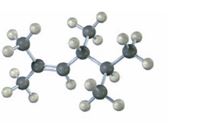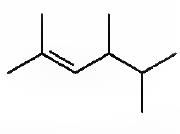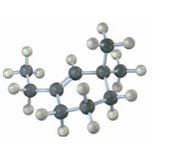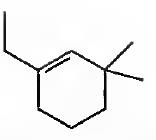
Concept explainers
a)

Interpretation:
To name the
Concept introduction:
The longest carbon chain containing the double bond to be chosen. Based on the name of the parent compound - the alkene name ends with the suffix -ene. The chain is to be numbered from the end that gives the lowest number to the carbon in double bond. Substituents are to be numbered according to their positions in the chain and listed alphabetically. The position of the double bond is indicated by giving the number of the first alkene carbon before the name of the parent name.
In skeletal structures the carbon and hydrogen atoms are not usually shown. Instead carbon atoms are assumed to be at each intersection of two lines and at the end of each line. Hydrogen atoms required are fitted mentally having in mind the valence of carbon is four. Atoms other than carbon and hydrogen are shown.
To name:
The alkene given and to draw its skeletal structure.
Answer to Problem 22VC
The IUPAC name of the compound is 2, 4, 5-trimethyl-2-hexene. Its skeletal structure is,

Explanation of Solution
The compound given has a continuous chain of six carbons with a double bond between C2 and C3 and three methyl substituents on C2, C4 and C5. Hence the name 2, 4, 5-trimethyl-2-hexene.
The IUPAC name of the compound is 2, 4, 5-trimethyl-2-hexene. Its skeletal structure is,

b)

Interpretation:
To name the alkene given and to draw its skeletal structure.
Concept introduction:
The maximum number of carbons in the ring is counted. Based on the name of the parent cycloalkane - the cycloalkene is named with the suffix -ene. The cycloalkane is numbered such that the double bond is in between C1 & C2 and the first substituent has the lowest number possible. Usually the position of a double bond is not shown in the name because it is always between C1 & C2. In dienes and trienes, however the position of double bonds is shown.
In skeletal structures the carbon and hydrogen atoms are not usually shown. Instead carbon atoms are assumed to be at each intersection of two lines and at the end of each line. Hydrogen atoms required are fitted mentally having in mind the valence of carbon is four. Atoms other than carbon and hydrogen are shown.
To name:
The alkene given and to draw its skeletal structure.
Answer to Problem 22VC
The IUPAC name of the compound is 1-ethyl-3, 3-dimethylcyclohexene. Its skeletal structure is,

Explanation of Solution
The compound given has a six membered ring with an ethyl group on C1 and two methyl groups both on C3. Hence the name is 1-ethyl-3, 3-dimethylcyclohexene.
The IUPAC name of the compound is 1-ethyl-3, 3-dimethylcyclohexene. Its skeletal structure is,

Want to see more full solutions like this?
Chapter 7 Solutions
OWLv2 with Student Solutions Manual eBook, 4 terms (24 months) Printed Access Card for McMurry's Organic Chemistry, 9th
- Q5: Label each chiral carbon in the following molecules as R or S. Make sure the stereocenter to which each of your R/S assignments belong is perfectly clear to the grader. (8pts) R OCH 3 CI H S 2pts for each R/S HO R H !!! I OH CI HN CI R Harrow_forwardCalculate the proton and carbon chemical shifts for this structurearrow_forwardA. B. b. Now consider the two bicyclic molecules A. and B. Note that A. is a dianion and B. is a neutral molecule. One of these molecules is a highly reactive compound first characterized in frozen noble gas matrices, that self-reacts rapidly at temperatures above liquid nitrogen temperature. The other compound was isolated at room temperature in the early 1960s, and is a stable ligand used in organometallic chemistry. Which molecule is the more stable molecule, and why?arrow_forward
- A mixture of C7H12O2, C9H9OCl, biphenyl and acetone was put together in a gas chromatography tube. Please decide from the GC resutls which correspond to the peak for C7,C9 and biphenyl and explain the reasoning based on GC results. Eliminate unnecessary peaks from Gas Chromatography results.arrow_forwardIs the molecule chiral, meso, or achiral? CI .CH3 H₂C CIarrow_forwardPLEASE HELP ! URGENT!arrow_forward
- Identify priority of the substituents: CH3arrow_forwardHow many chiral carbons are in the molecule? OH F CI Brarrow_forwardA mixture of three compounds Phen-A, Acet-B and Rin-C was analyzed using TLC with 1:9 ethanol: hexane as the mobile phase. The TLC plate showed three spots of R, 0.1 and 0.2 and 0.3. Which of the three compounds (Phen-A; Acet-B or Rin-C) would have the highest (Blank 1), middle (Blank 2) and lowest (Blank 3) spot respectively? 0 CH: 0 CH, 0 H.C OH H.CN OH Acet-B Rin-C phen-A A A <arrow_forward

 Organic ChemistryChemistryISBN:9781305580350Author:William H. Brown, Brent L. Iverson, Eric Anslyn, Christopher S. FootePublisher:Cengage Learning
Organic ChemistryChemistryISBN:9781305580350Author:William H. Brown, Brent L. Iverson, Eric Anslyn, Christopher S. FootePublisher:Cengage Learning Introduction to General, Organic and BiochemistryChemistryISBN:9781285869759Author:Frederick A. Bettelheim, William H. Brown, Mary K. Campbell, Shawn O. Farrell, Omar TorresPublisher:Cengage Learning
Introduction to General, Organic and BiochemistryChemistryISBN:9781285869759Author:Frederick A. Bettelheim, William H. Brown, Mary K. Campbell, Shawn O. Farrell, Omar TorresPublisher:Cengage Learning Chemistry & Chemical ReactivityChemistryISBN:9781337399074Author:John C. Kotz, Paul M. Treichel, John Townsend, David TreichelPublisher:Cengage Learning
Chemistry & Chemical ReactivityChemistryISBN:9781337399074Author:John C. Kotz, Paul M. Treichel, John Townsend, David TreichelPublisher:Cengage Learning



